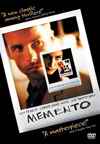Memento
Sony Pictures Home Entertainment
Cast: Guy Pearce, Joe Pantoliano, Carrie-Anne Moss
Extras: Director Interview, Short Story, Theatrical Trailers, TV Spot, Tattoo Gallery, Website Highlights, Cast & Crew
Rating:
"Memento" tells the story of Leonard Shelby (Guy Pearce), who is a man on a mission. Leonard is trying to track down the man who raped and killed his wife, and seek his revenge. That part of the story is fairly straight-forward. But, Leonard was also assaulted during the attack on his wife, and was left with a unique form of brain damage. Leonard has no short-term memory, and thus is no longer capable of forming new memories. He can remember his life before the attack, but nothing that has happened since then sticks in his mind. Thus, Leonard has become a man who relies on taking notes. He writes notes to himself and has the most important information tattooed to his body. Using the scraps of information that Leonard has been able to give himself, he seeks out the man who murdered his wife. But, how can a man who can’t remember what happened 15-minutes ago manage to solve such a mystery? And when he meets people such as Teddy (Joe Pantoliano) and Natalie (Carrie-Anne Moss), who claim they want to help him, how can he be sure that they really are who they say they are?
But writer/director Chris Nolan (who based the film on an idea from his brother Jonathan) doesn’t stop there. Nolan has gone one step further in making "Memento" a truly unique experience, but deciding to tell the story backwards. Yes, the film opens with the conclusion of Leonard’s story, and then works its way backwards. The film is broken up into individual segments, and each one ends where the one before it began. This may sound confusing, and, in truth, it is. But, it doesn’t take long to understand how the story is going to be told. Using this method, Nolan is able to truly put the audience into Leonard’s shoes. Leonard can’t remember his past, and the audience is slowly learning what Leonard’s past was, as the story unfolds… or would that be folds up? What’s even more amazing is that amount of tension and suspense this technique creates. Instead of wondering what’s going to happen, as we would in a normal thriller, we already know what has happened. Now, we must learn what actions took place that lead up to the events that we’ve witnessed. Also, we are able to learn tidbits that Leonard forgets, so this creates tension as well. As if Nolan’s approach to the material wasn’t impressive enough, he has shot "Memento" in a very interesting style, blending color and black & white photography. "Memento" is a truly original film, and the shock-beginning will have you pondering the film for days.
The audio on the "Memento" DVD is a <$DD,Dolby Digital> <$5.1,5.1 channel> soundtrack, which sounds very good. This track is very bold, flexing its surround sound muscles at every opportunity. The dynamic range is very impressive and the on-screen action to speaker placement of the sound effects is one of the best that I’ve heard lately. The score by David Julyan sounds fine on this track, and lends a nice bass-response to the audio. Naturally, we are treated to clear and audible dialogue and no hissing on the track. "Memento" is a film about a man who must rely on his senses in any given situation, and the audio and video presentation here really help to immerse the viewer into that world.
The DVD includes a <$PS,fullframe> version of the theatrical trailer for "Memento" and a <$PS,letterboxed> TV spot. We are also treated to a <$PS,fullframe> trailer for Nolan’s first film, "Following". There is a photo gallery, which gives us concept illustrations for Leonard’s tattoos and how they compared to the finished product in the film. Also, the disc offers biographies of the principal cast and crew. The strangest extra is a feature which allows you to examine some of the highlights of the "Memento" website. These very creative photo and text offerings definitely capture the tone of the film.
I have read many complaints from individuals on the Internet who were concerned with the fact that this DVD doesn’t give one the option to watch the film in its chronological order. (Although, if you know how to program your DVD player, this could easily be done.) I have to say that these complaints are groundless and somewhat presumptuous. Watching the story from beginning to end would ruin the movie. Yes, there would be a moment of shock at the ending (which is actually the beginning of the film), but it would not compare to the conclusion that the film reaches in its present form. Watching the film in this manner would not help the film to be more accessible and destroy the intended editorial flow. Having the film on DVD, where you can easily rewind, or watch the film over and over, will help to make the story clearer.
"Memento" is one of the most original and gripping thrillers ever made, and it is easily the best film of the year thus far. The DVD brings us a stunning transfer with an equally impressive soundtrack. Even if you have to write yourself a note, remember to see "Memento".







